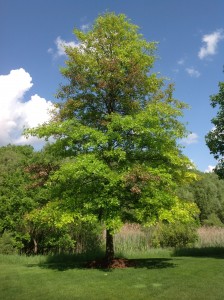I am serving on a Ph.D. committee for a student working in Entomology and Plant Pathology who is defending his dissertation tomorrow morning. I’m taking a break from trying to plow through the longest dissertation in history: A 465 page tome on the use of trunk injection in tree fruit crops. A lot to wade through but a fascinating topic. Trunk injection, of course, is not a new topic. Some of the earliest references to injecting compounds into trees date back to Leonardo daVinci, who also suggested the ‘pipe model’ theory of tree architecture; the notion that total cross-sectional area of a tree is constant as you move up to higher and higher levels of branching.

Trunk injection can be useful in lots of applications. We have done some research in my lab on the use of trunk-injected imidacloprid for treating ash trees for emerald ash borer. The compound is highly effective against the beetle but using C-14 radio-labeled imidacloprid we were able to demonstrate the flow up the trunk of ash trees can be ‘sectored’, potentially resulting in ‘hot’ and ‘cold’ spots in the crown where the adult beetles feed on leaves.

On the MSU campus our arborists have been successfully using trunk-injected fungicide applications to protect our remaining elm trees from Dutch elm disease (DED). Prior to the arrival of DED the MSU campus had about 3,000 elm trees; today we have less than 300. Under the current program the trees are treated with propiconazole in a three-year rotation; 100 trees each year. We still lose a tree or two each year but the program is largely effective.

One application of trunk injection of which I am dubious is for treatment of nutrient deficiencies. It’s not that trunk injection is not effective for this purpose; in fact, it is often highly effective. The problem is treating nutrient deficiencies with trunk injection just treats the symptom rather than the underlying cause. Here in the Midwest a common scenario is iron chlorosis in pin oaks. The fundamental problem is that alkaline soil conditions limit iron uptake. The solution? First, right tree – right place. Don’t plant pin oak if you have alkaline soils. Second, if it’s an existing tree, work on lowering the pH with sulfur or ammonium sulfate. Remember, trees have evolved or God designed them – take your pick – to take up nutrients through their roots. Dealing with that end of the equation is the best solution in the long run.





















